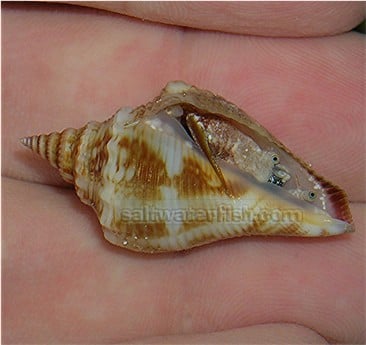Fighting Conch (Strombus gibberulus)
Quick Stats:
- Care Level: Easy
- Temperament: Peaceful
- Diet: Herbivore
- Reef Safe: Yes
- Minimum Tank Size: 20 gallons
- Max Size: 3 inches
- Water Parameters:
- Temperature: 72°F – 78°F
- Salinity: 1.023 – 1.025
- pH: 8.1 – 8.4
- Ammonia: 0 ppm
- Nitrite: 0 ppm
- Nitrate: < 10 ppm
Fighting Conch (Strombus gibberulus) – Comprehensive Guide:
The Fighting Conch, scientifically known as Strombus gibberulus, is a species commonly found in saltwater aquariums. It is native to the Indo-Pacific region and is known for its vibrant colors and interesting behavior.
Habitat:
The Fighting Conch is typically found in shallow sandy areas and seagrass beds. It prefers areas with moderate water flow and plenty of hiding spots.
Reef Safe:
The Fighting Conch is considered reef safe as it does not typically bother corals or other invertebrates. In fact, it can be beneficial to a reef aquarium as it helps to sift and aerate the substrate.
Reef Cleaner:
The Fighting Conch is considered a reef cleaner due to its feeding habits. It primarily feeds on detritus, algae, and uneaten food, helping to keep the aquarium clean and free from excess organic matter.
Size:
The Fighting Conch can grow up to 3 inches in length. It starts off small but gradually reaches its maximum size over time.
Sexual Dimorphism:
There is no significant difference in appearance between male and female Fighting Conchs.
Lifespan:
The average lifespan of a Fighting Conch is around 2-3 years, although with proper care, they can live longer.
Diet in Aquariums:
In aquariums, the Fighting Conch is primarily herbivorous. It feeds on algae, detritus, and leftover food. Providing a varied diet that includes seaweed sheets, algae pellets, and occasional meaty foods like brine shrimp or mysis shrimp is recommended.
Aquacultured Availability:
The Fighting Conch is not commonly aquacultured, but it is readily available to hobbyists through sustainable collection practices.
Compatibility with Tankmates:
The Fighting Conch is generally peaceful and can be kept with a variety of fish, invertebrates, and corals. Here are five tankmates that are good choices:
- Clownfish: They are compatible due to their peaceful nature and similar water parameter requirements.
- Cleaner Shrimp: They can coexist as the Fighting Conch will not harm or bother the shrimp.
- Soft Corals: The Fighting Conch is reef safe and will not damage or disturb soft corals.
- Snails: They can help with the cleanup and will not compete for resources with the Fighting Conch.
- Gobies: They make good tankmates as they inhabit different areas of the aquarium and have compatible temperaments.
Temperament:
The Fighting Conch is known for its peaceful nature and is generally not aggressive towards other tank inhabitants. It spends most of its time scavenging for food and exploring the substrate.
Other Common Names:
The Fighting Conch is also known by other common names such as the Tiger Conch or the Spotted Conch.
Why Buy from Reefs4Less.com:
Reefs4Less.com is a reputable online retailer that specializes in saltwater aquarium supplies. Here are a few reasons why you should consider buying from them:
- Wide Selection: Reefs4Less.com offers a wide range of marine livestock, including the Fighting Conch, ensuring you have options to choose from.
- Quality Assurance: They prioritize the health and well-being of their livestock, ensuring that you receive healthy and vibrant specimens.
- Expert Advice: Their team of experienced professionals is available to provide guidance and support, helping you make informed decisions for your aquarium.
- Convenience: With online shopping, you can conveniently browse and purchase the Fighting Conch from the comfort of your own home.
- Shipping: Reefs4Less.com offers reliable shipping options to ensure the safe delivery of your livestock.
Popular Questions and Answers:
Q: Can the Fighting Conch be kept in a smaller tank?
A: While the minimum tank size for a Fighting Conch is 20 gallons, providing a larger tank with ample space is recommended for their well-being and natural behavior.
Q: Do Fighting Conchs require a sandy substrate?
A: Yes, Fighting Conchs prefer a sandy substrate as it allows them to bury themselves partially, mimicking their natural habitat.
Q: Are Fighting Conchs suitable for a beginner saltwater aquarium?
A: Yes, Fighting Conchs are considered suitable for beginners due to their easy care requirements and peaceful nature.
Q: Can Fighting Conchs reproduce in a home aquarium?
A: While it is possible for Fighting Conchs to reproduce in a home aquarium, it is challenging to provide the specific conditions required for successful reproduction.
Q: How can I encourage natural feeding behaviors in my Fighting Conch?
A: Providing a varied diet, including live or frozen foods, seaweed sheets, and occasional meaty foods, will help stimulate their natural feeding behaviors.
| Size | 1-2 inches |
|---|


Reviews
There are no reviews yet.